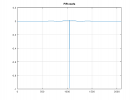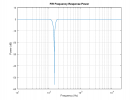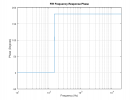Instead of actually building a speaker, you can also have a lot of fun simulating one, and learning something along the way 
In that spirit, I was contemplating the following scenario: I'd like to add some acoustic damping to my room, but I'd also want to have some wife friendly surround setup, that still performs halfway decent. So why not try to combine the two?
This is what I came up with: Why not build a shallow speaker panel that is actually mostly built out of acoustic absorption material, but also houses the speaker units. Covering the whole with a proper and nice-looking fabric will make it just look like just a panel, rather than a surround speaker. That way I could cover the rear and side surround channels, giving much-needed room damping especially to the wall behind the listeners. Furthermore, one could hide some speakers on the top side to act as Atmos height channels. But that's not the focus for today
So a wall near the panel has some challenges, as well as some advantages. Firstly, because of the wall closeness, you get quite a boost in bass response, so little or no baffle step compensation is needed. Secondly, you get some massive size constraints. Only small or shallow build units will fit. So choices are rather limited.
Now I thought, how about a line array? You can use multiple smaller speakers to get decent output, and if we can hit 80 Hz, we should be more or less okay. Now I didn't want to break my virtual bank either, so the line has to be not very long. 5 units would be the maximum for this experiment.
Driver choice needs to be something cheap and decent, with enough high-frequency extension to not need a tweeter. My choice is the FaitalPro 4FE32:

They are about 20 euro's each if you buy 5, cheaper if you buy more For that, you get a smooth driver with a neo motor and low distortion profile and resonance figures.
For that, you get a smooth driver with a neo motor and low distortion profile and resonance figures.
So let's line them up and see. For this I used Boxsim. It's a tool that has been around for quite a while and might be familiar to people using Visaton drivers since it comes with a full dataset of those drivers. I've used it several times before and it's quite okay, but a bit clunky. There are other options for sure, but I know how to use it, and I have it running without issues on my Mac (as opposed to some of the other free tools out there).
First up a normal 5-unit vertically aligned array. I offset the drivers on the panel (of roughly 50x50cm) to about 1/3 of the right side. This will improve the radiation pattern a bit in the sims, but in the real world, when the panel is against the wall, this should not matter. I use Engauge Digitizer (very klunky tool) to trace the frequency response and impedance plots from the datasheet and entered all the data in Boxsim.

Top image is horizontal coverage, bottom is vertical. Clearly the vertical has the typical narrowing of the line array. This can also clearly be seen in the directivity plot:

Now One major issue here is obviously that ceiling and floor reflections will be quite unpredictable. Sadly Boxsim can't simulate this. The good news is the power handling. Since the Faital driver already brings 2.5mm Xmax, is can take quite a beating. This configuration in bass-reflex should be fine for > 115 dB at 1m from around 100 Hz on.
But the vertical dispersion bugs me. Now I found some pages about a Bessel type of array. It shaded the drivers to a Bessel function, and that way improves vertical dispersion. There are several configurations possible, and even some improvements are possible on the original design. I however found that they mostly bring a bit more bass efficiency, and worse off-axis response, mostly in the midrange.
So I settled for the most simple setup with a 5 driver setup. shading is:
.5 -1 1 1 .5
So the outer woofers are at half power, the rest is full power, with one of the three inverted. So what does that look like:

Wow , now suddenly the vertical looks quite good as well. The downside is that we lost about 5 dB inefficiency. Consequently the polars looks quite nice:
, now suddenly the vertical looks quite good as well. The downside is that we lost about 5 dB inefficiency. Consequently the polars looks quite nice:


Obviously, the max SPL is down by about 5dB as well, but it's still not bad. Also, I cheated a bit with the response: I added a few PEQ's to smooth it out a bit, which in reality I would have done anyway. Also note that I used the 8 Ohm version. This ends up with a quite low impedance, so is not very amp friedly. You could do the same with the 16 Ohm version as well, and that would give you a resonable impedance. Just did not have to time to redo the whole thing.
All in all, I think this is quiet an interesting option for such speaker, and I'm actually contemplating making them and see how good it really works
In that spirit, I was contemplating the following scenario: I'd like to add some acoustic damping to my room, but I'd also want to have some wife friendly surround setup, that still performs halfway decent. So why not try to combine the two?
This is what I came up with: Why not build a shallow speaker panel that is actually mostly built out of acoustic absorption material, but also houses the speaker units. Covering the whole with a proper and nice-looking fabric will make it just look like just a panel, rather than a surround speaker. That way I could cover the rear and side surround channels, giving much-needed room damping especially to the wall behind the listeners. Furthermore, one could hide some speakers on the top side to act as Atmos height channels. But that's not the focus for today
So a wall near the panel has some challenges, as well as some advantages. Firstly, because of the wall closeness, you get quite a boost in bass response, so little or no baffle step compensation is needed. Secondly, you get some massive size constraints. Only small or shallow build units will fit. So choices are rather limited.
Now I thought, how about a line array? You can use multiple smaller speakers to get decent output, and if we can hit 80 Hz, we should be more or less okay. Now I didn't want to break my virtual bank either, so the line has to be not very long. 5 units would be the maximum for this experiment.
Driver choice needs to be something cheap and decent, with enough high-frequency extension to not need a tweeter. My choice is the FaitalPro 4FE32:
They are about 20 euro's each if you buy 5, cheaper if you buy more
So let's line them up and see. For this I used Boxsim. It's a tool that has been around for quite a while and might be familiar to people using Visaton drivers since it comes with a full dataset of those drivers. I've used it several times before and it's quite okay, but a bit clunky. There are other options for sure, but I know how to use it, and I have it running without issues on my Mac (as opposed to some of the other free tools out there).
First up a normal 5-unit vertically aligned array. I offset the drivers on the panel (of roughly 50x50cm) to about 1/3 of the right side. This will improve the radiation pattern a bit in the sims, but in the real world, when the panel is against the wall, this should not matter. I use Engauge Digitizer (very klunky tool) to trace the frequency response and impedance plots from the datasheet and entered all the data in Boxsim.
Top image is horizontal coverage, bottom is vertical. Clearly the vertical has the typical narrowing of the line array. This can also clearly be seen in the directivity plot:
Now One major issue here is obviously that ceiling and floor reflections will be quite unpredictable. Sadly Boxsim can't simulate this. The good news is the power handling. Since the Faital driver already brings 2.5mm Xmax, is can take quite a beating. This configuration in bass-reflex should be fine for > 115 dB at 1m from around 100 Hz on.
But the vertical dispersion bugs me. Now I found some pages about a Bessel type of array. It shaded the drivers to a Bessel function, and that way improves vertical dispersion. There are several configurations possible, and even some improvements are possible on the original design. I however found that they mostly bring a bit more bass efficiency, and worse off-axis response, mostly in the midrange.
So I settled for the most simple setup with a 5 driver setup. shading is:
.5 -1 1 1 .5
So the outer woofers are at half power, the rest is full power, with one of the three inverted. So what does that look like:
Wow
Obviously, the max SPL is down by about 5dB as well, but it's still not bad. Also, I cheated a bit with the response: I added a few PEQ's to smooth it out a bit, which in reality I would have done anyway. Also note that I used the 8 Ohm version. This ends up with a quite low impedance, so is not very amp friedly. You could do the same with the 16 Ohm version as well, and that would give you a resonable impedance. Just did not have to time to redo the whole thing.
All in all, I think this is quiet an interesting option for such speaker, and I'm actually contemplating making them and see how good it really works



